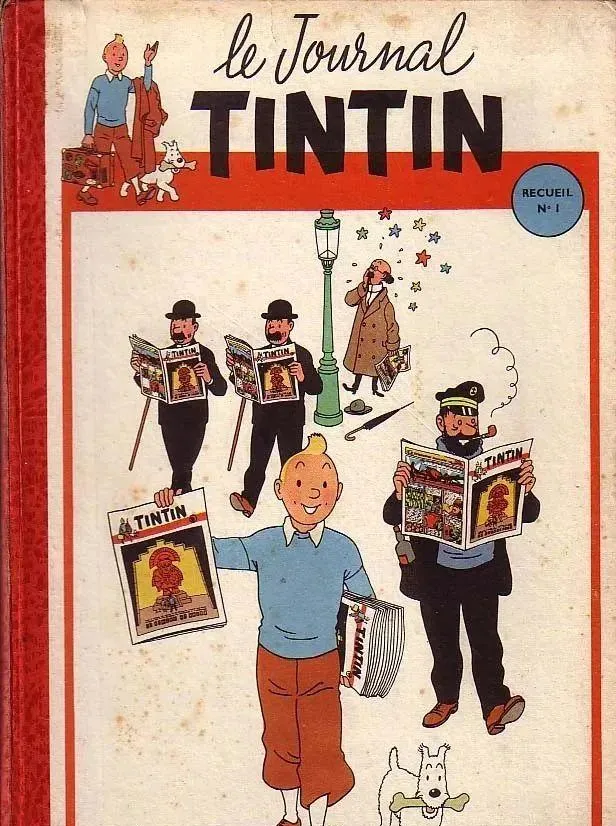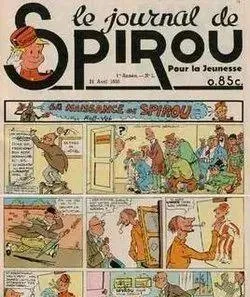什麽是Bande Dessinée?
「Bande dessinée」意為「法語漫畫」。比利時和法國人所說的「bande dessinée」或「BD」與世界上任何其他類別的漫畫都大不相同。它不同於西方漫畫、日本漫畫和美國超級英雄漫畫,而是擁有它自己的表達方式,而100多年的歷史早已讓它成為比利時文化的一部份。
自文藝復興時期以來,視覺藝術就在比利時文化中占有重要地位,例如眾所周知的比利時畫家:布勒哲爾(Brueghel)、揚·凡·艾克(Van Eyck)、魯本斯(Rubens)……幾個世紀後的50 年代,布魯塞爾成為了當時全歐洲擁有最多電影院的城市。因此,法語國家所謂的「第九藝術」,即漫畫在比利時的興起絕非巧合!

一般來說,漫畫早在19 世紀早期就有記載,但是漫畫創作和出版最多的黃金時代是在一百多年之後。下面就讓我們一起來了解比利時漫畫的歷史吧。
What people in Belgium and France call a 「bande dessinée」 or 「BD」 is very different from any other types of comic found in the world. It is unlike the far eastern manga, manhwa or manhua or the American superheroes comics. It is its own way of storeytelling, and in more than a 100 years of existence, it has become part of Belgium’s culture.
Visual arts have had a great cultural importance in Belgium since the Renaissance period with painters known to everyone: Brueghel, Van Eyck, Rubens… A few centuries later in the 1950s, Brussels was the city that had the most cinemas in all of Europe. As such, the rise of what francophone countries call the 「9th form of art」, or comics, in Belgium was not a coincidence!
Comics in general can be found as early as the early 19th century, but the golden era, during which the most comics were written and published, took place more than a hundred years later. Let us delve into the early history of Belgian comics.
比利時漫畫的歷史
HISTORY
PHASE1
1929年1月10日,「丁丁」首次在【二十世紀報】(Le Vingtième Siècle)的兒童周刊【小二十世紀報】(Le Petit Vingtième)上釋出。這一時間點標誌著比利時漫畫的誕生。與我們現在經常看到的那些一次性釋出的漫畫不同,丁丁的故事是以連載的形式逐個釋出的。釋出後,「丁丁」大受歡迎,於是該周刊決定將這些故事以精裝書的形式發行:1930 年,【丁丁在蘇聯】出版。「丁丁」的故事起初在日報上連載,直到 1946 年周刊 【丁丁報】(Le Journal de Tintin)創刊。

1934年8月2日「丁丁」在【小二十一世紀報】上
Tintin on Le Petit Vingtième on August 2nd in 1934
On 10 January 1929, Tintin is published for the first time in the 「Petit Vingtième」 a weekly supplement for children to the newspaper 「Le Vingtième Siècle」. This point in time effectively marks the birth of the Belgian comic. Stories were published part by part instead of all at once like we are used to nowadays. However, Tintin was so popular that the magazine decided to release the stories in hardcover book format as well: in 1930, Tintin au Pays des Soviets (Tintin in the Land of the Soviets) is published. The stories were first released in daily newspaper until the creation, in 1946, of the weekly magazine Le Journal de Tintin.
PHASE2
在第二次世界大戰期間,【二十世紀報】停刊,迫使「丁丁」的作者埃爾熱為他筆下小記者的冒險經歷另尋發表基地。在 【晚訊報】(le Soir)短暫連載後,一家出版社將在 1946 年出版的名為【丁丁報】(Le Journal de Tintin)的新雜誌中繼續更新【丁丁歷險記】。該雜誌的副標題是「7至77歲年輕人適讀雜誌」,每周出版一直持續至1993年。

During the Second World War, the Vingtième Siècle is closed which forces Tintin’s author Hergé to look for another opportunity to publish the adventures of his reporter somewhere else. After a short stay at the le Soir (the Evening times), a publishing company will offer to continue The Adventures of Tintin in a new magazine, called Le Journal de Tintin in 1946. The magazine, subtitled "The Magazine for the Youth from 7 to 77", kept on publishing every week until 1993.
PHASE3
30年代,位於沙勒羅瓦附近馬西內勒地區的著名出版商Jean Dupuis決定創辦一本以新角色「斯皮魯(Spirou)」為主角的青年雜誌。

Back in the 1930s, Dupuis, a publisher based in Marcinelle near Charleroi which mainly publishes family magazines, decides to start a youth magazine centred around a new hero, 「Spirou」.
PHASE4
【丁丁報】(Le Journal de Tintin)和【斯皮魯報】(Le Journal de Spirou)逐漸成熟,許多如今在比利時家喻戶曉的系列漫畫也是在這兩本雜誌上起步的,例如:【蘇蘇和維維歷險記】(Suske en Wiske)、【幸運星盧克】(Lucky Luke)、【IQ零蛋多毛狗】(Cubitus)、【奧丁的詛咒】(Thorgal)等等……當時這兩本雜誌是友好的競爭對手;甚至理論上,正是由於這種良性的競爭促使漫畫家能夠產出更多更好的作品,讓我們今天可以欣賞如此多的漫畫。

The Journal de Tintin and Journal de Spirou will be the starting platforms for many other popular comic series that are now household names in Belgium: Suske en Wiske, Lucky Luke, Cubitus, Thorgal and much more… The two magazines were friendly rivals; it can even be theorized that it is this very competition that pushed each author to write better and write more, and gave us the many comics which we can enjoy today.
PHASE5
這兩本期刊的主要區別之一在於顯著的風格差異:雖然「斯皮魯」有更多漫畫人物的幽默故事(例如標誌性的「大鼻子」),但丁丁在繪制現實主義畫面時則更為嚴肅。另外有些漫畫並不發表在期刊上,而是在其他地方出版,例如經典的荷蘭語漫畫【傑米歷險記】(Jommeke),如今仍在荷蘭主流報紙【新聞報】(Het Nieuwsblad)和【標準報】(De Standaard)上連載。

One main difference between the two journals was their significant style difference: While Spirou had more humoristic stories with caricatured characters (such as the signature 「big noses」), Tintin was more serious with relatively realistic drawings. Some comics didn’t belong to any of the journals and were published somewhere else, like the classic Dutch language comic 「Jommeke」 which is still published nowadays in mainstream Dutch language newspapers Het Nieuwsblad and De Standaard.
可能有人會說比利時漫畫的黃金時代已經過去,但實際上比利時仍有源源不斷的新漫畫,如今仍有許多孩子在閱讀【斯皮魯】雜誌!
但是不要誤會哦:比利時漫畫不僅僅是專供兒童閱讀的。正如丁丁雜誌的口號所說——是為 7 到 77 歲的年輕人而準備的。比利時漫畫適合每個人,就像藍精靈一樣擁有多層故事。比利時漫畫很受歡迎的另一個原因在於:對於兒童來說其中的幽默很容易理解,但對成年人來說就沒那麽容易了。比利時漫畫制作精良,每一個故事圍繞的主題並不受年齡或文化的限制。最重要的是,這些角色都很可愛,以一種古怪而又非常比利時的方式感染著每一位讀者。
Some might say that the golden age of the Belgian comic has passed, but new comics are still being created and lots of kids still read the Spirou magazine nowadays!
Don’t misunderstand though: Belgian comics are not only for children. As the slogan of the Tintin magazine said, they’re for the youth from 7 to 77. Belgian comics are written for everyone, often containing several layers of stories like in the Smurfs. That is exactly why they are enjoyed by some many people: the humour is accessible for children but subtle enough to be interesting for adults. The stories are well-crafted and revolve around topics that are not restricted to an age or a culture. And most importantly, the characters are loveable, in their own quirky, very Belgian way.
近期其他文章推薦:
駐滬總領館紀念俄對烏發動侵略戰爭兩周年舉辦非正式聚會 Informal Gathering to Support Ukraine
我們為什麽要將新館的庭院以天寶命名?Why did we name our courtyard after TianBao?
下周開幕!到皇家美術博物館來一次超現實主義之旅吧!Catch "Imagine!" in Brussels!
她從蓋世太保的槍口下救了近百名比利時人 Qian Xiuling Hall: Why Do We Commemorate Her
比利時駐華大使館
微訊號|比利時駐華大使館
新浪微博|比利時駐華使館
網站|china.diplomatie.belgium.be • www.belgium24.eu











